Sur cette page, on dérive quelque peu de la stéréoscopie ! J'ai découvert l'illustrateur Jean-Jacques Grandville par la stéréoscopie, dont une série de vues a reconstitué avec des personnages en pâte à modeler des scènes des Métamorphoses du Jour. Ceci en 1859, en s'inspirant des rééditions des planches de cette époque. Et puis j'ai découvert à partir du joli livre du musée de Nancy sur l'exposition Grandville de 2003, que des scènes des Métamorphoses avaient été reportées très fidèlement sur des assiettes à dessert.
Ces assiettes, qui appartiennent à la grande tradition des assiettes historiées de Choisy le Roi, Creil et autres manufactures, évoquent pour moi de vieux souvenirs d'enfance. Alors en vacances chez mes grands-parents, à la fin du déjeuner du dimanche, j'allais choisir dans la cuisine l'assiette historiée dans laquelle j'allais déguster mon dessert. Un service à dessert déjà largement centenaire, qui s'était transmis de génération en génération. J'imagine au 19ème siècle, quand culmine cet engouement, les fin de repas égayées à comparer son assiette aux autres, ou à essayer de découvrir les rébus. Il y a des petits amusements simples qui se sont perdus avec le temps.
S'il faut justifier la présence de ces assiettes sur un site dédié à la photographie stéréoscopiques, remarquons qu'elles appartiennent pleinement à cette société du 19ème siècle à la fois légère et en pleine mutation. Les assiettes, les stéréos participaient l'une comme l'autre à l'animation de ces déjeuners de famille ou réunions de salons de la bourgeoisie, si représentés dans les scènes de genre.
On this page, we derive from the stereoscopy! I discovered the illustrator Jean-Jacques Grandville by the stereoscopy, a series of which reconstituted with characters in clay or clay planks of the "Metamorphosis of the Day". This in 1859, inspired by the reissues of that time. And then I discovered from the pretty book of the museum of Nancy on the exhibition Grandville of 2003 that scenes of the Metamorphoses had been reported very faithfully on dessert plates.
These plates, which belong to the great tradition of the historiated plates of Choisy le Roi, Creil and other manufacturers, evoke old childhood memories for me. So on vacation at my grandparents' house, at the end of Sunday lunch, I would go to the kitchen to choose the historiated plate on which I would enjoy my dessert. An almost century-old dessert, which had been passed down from generation to generation. I imagine in the 19th century, when this craze peaked, the end of meals brightened up by comparing one's plate to others, or trying to discover the rebuses. There are simple little amusements that have been lost over time..
If we have to justify the presence of these plates on a site dedicated to stereoscopic photography, let us note that they present a complementary aspect of this 19th century society, both carefree and in full mutation. The plates and the stereos participated in the animation of these family lunches or meetings of bourgeois salons, so represented in genre scenes.
Cette série intitulée en marge du décor «Métamorphoses» a été fabriquée à Choisy Le Roi par Paillart et Hautin, comme l'indique la marque «P&H» au verso. Celle-ci a été apposée sur les assiettes dans la période 1824-1835, ce qui fait qu'on a la certitude que ces assiettes ont été fabriquées entre 1829 - date de sortie des Métamorphoses du Jour - et 1835.
Il s'agit d'une série de 12 pièces. On les trouve en deux diamètres, 20,5 et 21,5 cm. Elles portent toutes au dos un petit écusson en creux avec inscrit à l'intérieur sur 3 lignes : «P&H / Choisy / 20». Toutes portent sur le bord bas droit du dessin un numéro, qui parfois est cependant trop excentré pour apparaître. En inspectant plusieurs exemplaires, le numéro de chaque assiette a pu être identifié avec certitude, sauf celui de l'assiette N°9.
Le décor central en noir et blanc est apposé par transfert au centre de l'assiette. La série est fabriquée en deux choix : en noir et blanc, et avec le décor colorié à la main - dont les coloris peuvent varier entre les exemplaires d'un même décor.
Les décors recopient très fidèlement les planches de Grandville. De ce point de vue, il s'agit plus d'artisanat que d'art, le savoir faire étant purement technique. Il en est de même pour les autres séries d'assiettes, dont peu des scènes représentées sont des créations. Il n'y a qu'une exception : Sur l'assiette n°1, le benêt en train de se faire voler tient un journal anonyme sur la planche de Grandville, que le faiencier a tranformé sur l'assiette en journal royaliste, faisant sans aucun doute état de ses convictions républicaines.
On a reproduit pour chaque assiette la planche originale correspondante des Métamorphoses du Jour dans la première édition de Bulla parue en 1829.
La même année est parue une édition bilingue français - anglais. Sur la planche 41 d'un exemplaire on lit «London 1st January 1829. Published by Mr Lean 26 hay market». Une partie des traductions qui suivent provient de cette édition, qui s'est arrêtée à la planche 43 (*).
This series was made in Choisy Le Roi by Paillart and Hautin, as indicated by the mark «P&H» on the back. It was affixed to the plates in the period 1824-1835, so that we have the certainty that these plates were made between 1829 - date of release of the Metamorphoses of the Day - and 1835.
Obviously this is a series of 12 plates. They are available in two diameters, 20.5 and 21.5 cm. They all bear the same hollow mark on the back: a shield with the following written inside on 3 lines: “P&H / Choisy / 20”. All of them have number on the lower right edge of the drawing, which is sometimes too off-centre to be visible. By inspecting several copies, the number of each plate was identified with certainty, except for plate 9.
The central black and white decoration is affixed by transfer to the center of the plate. The series is manufactured in two choices: in black and white, and with the decoration colored by hand - whose colors may vary between copies of the same decoration -.
The designs faithfully replicate Grandville's plates. From this perspective, it is more a matter of craftsmanship than art, the expertise being purely technical. The same is true for the other series of plates, few of the scenes depicted being original creations. There is only one exception: On plate no. 1, the fool being robbed is holding an anonymous newspaper on the Grandville drawing, which the faience maker has transformed on the plate into a royalist newspaper, undoubtedly stating his republican convictions.
For each plate, the corresponding original plate from the Métamorphoses du Jour in the first edition of Bulla published in 1829 has been reproduced.
At the same year has been published a bilingual edition french-english. On the plate 41 of an exemplar, we have read «London 1st January 1829. Published by Mr Lean 26 hay market». Some of the translation following are from this edition.
Une autre série a été fabriquée à Creil, bien moins rare et avec l'aile assez chargée de personnages des Métamorphoses.
Série de 12 assiettes en 2 choix : noir et blanc, couleur. aile constituée des bustes des personnages des Métamorphoses, dans un décor floral. Dans la partie centrale, légende «Métamorphoses du Jour». Dessous, une scène reprise fidèlement des planches de l'édition de 1829, avec sa légende.
Les assiettes ne sont pas numérotées, et correspondent aux planches suivantes de l'édition de 1829 :
Another series was made in Creil, much less rare and with a peripheral decoration quite over-ornate with characters of the Metamorphoses.
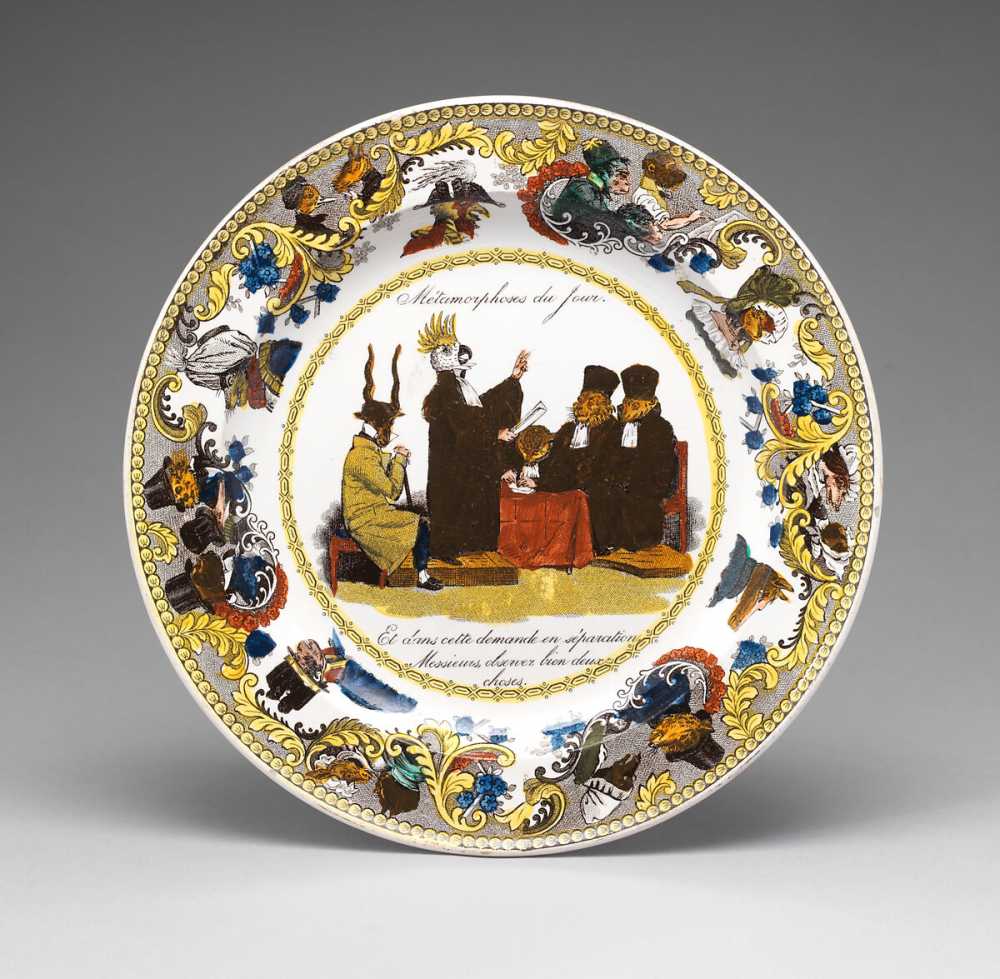
La faïencerie est créée en 1805 par les frères Paillart (Valentin Melchior et Nicolas), dans le parc du château de Choisy.
De 1824 à 1836, elle est dirigée par Valentin Paillart et son associé Hippolyte Hautin. À cette période est apposée au dos en creux la marque «P&H».
En 1836, Valentin Paillart quitte l'entreprise et Hippolyte Hautin s'associe à Louis Boulenger. La descendance des deux familles conserve l'entreprise, qui devient en 1863 «H. Boulenger & Cie».
En 1889 l'entreprise obtient les deux-tiers du marché des carreaux de faïence des murs du métro parisien, ce qui l'incite à transférer le siège social à Paris, 18, rue de Paradis, qui est aussi un magasin de vente. On peut aujourd'hui encore admirer l'étonnante façade néo-renaissance ornée de céramiques.
En 1920, l'entreprise rachète la marque Creil-Montereau. En 1936 les ateliers de Choisy sont fermés (et la manufacture détruite en 1952). En 1955 les ateliers de Montereau ferment à leur tour.
Aujourd'hui, la société ne produit plus que des revêtements de sol.
The earthenware factory was created in 1805 by the Paillart brothers (Valentin Melchior and Nicolas), in the grounds of the Choisy castle.
From 1824 to 1836, it was directed by Valentin Paillart and his associate Hippolyte Hautin. At this period is affixed to the back in hollow the mark "P&H".
In 1836, Valentin Paillart left the company and Hippolyte Hautin joined forces with Louis Boulenger. The descendants of the two families kept the company, which in 1863 became “H. Boulenger & Co.
In 1889 the company obtains two-thirds of the market for earthenware tiles for the walls of the Paris metro, which encourages it to transfer the head office to Paris, 18, rue de Paradis, which is also a sales store. You can still admire the astonishing neo-Renaissance facade decorated with ceramics.
In 1920, the company bought the Creil-Montereau brand. In 1936 the Choisy workshops were closed (and the factory destroyed in 1952). In 1955 the Montereau workshops closed in turn.
Today, the company only produces floor coverings.
Sources :
(*) Georges Vicaire, Manuel de l'amateur de livres du XIXe siècle, 1801-1893, Tome V p.789. Lien Gallica.
Sauf mention particulière, les planches proviennent de la Maison de Balzac.
Unless otherwise stated, the plates come from the Maison de Balzac.
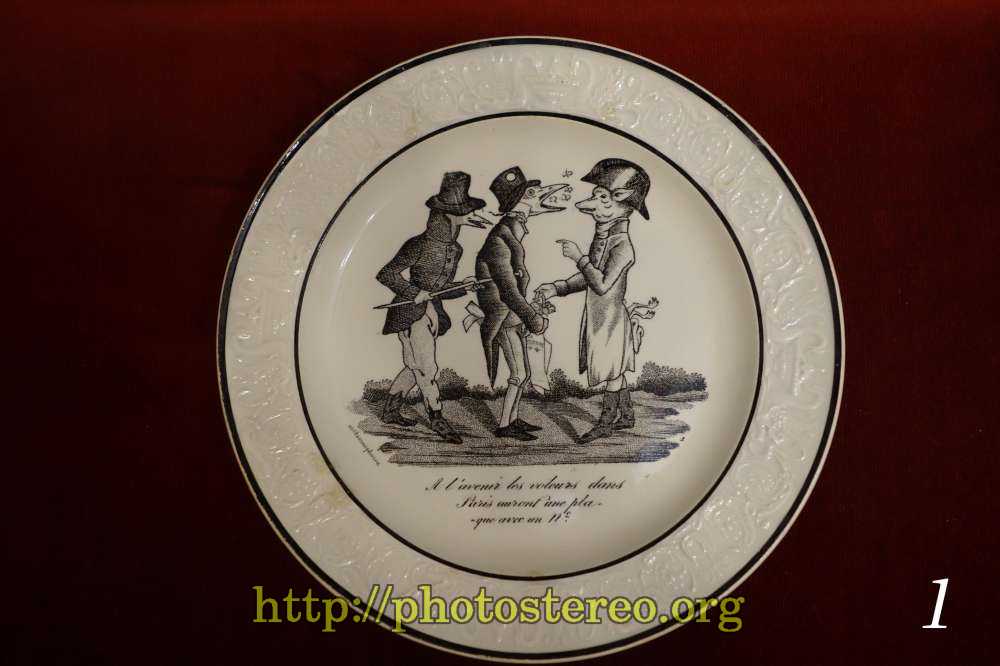
Un homme à tête d'oiseau prêt à gober les mouches se fait détrousser de sa montre par un homme à tête de renard. Un comparse à tête de pie empêche la fuite de la victime. L'illustrateur de l'assiette a rajouté le nom du journal qu'elle tient : Il s'agit de «La Quotidienne», facilement identifiable par la rangée de fleurs de lys sous le titre, journal royaliste qui parait entre 1790 et 1848. Cela ajoute une touche politique au dessin, où les voleurs apparaissent droits et décidés, et le volé mal sapé, maigre, perdu, et plus encore réactionnaire.
La légende est assez enigmatique, dont voici une proposition d'explication : Les voleurs sont si bien installés dans Paris qu'il faudrait les enregistrer administrativement comme n'importe quelle profession autorisée.
A man with a bird's head ready to swallow flies is robbed of his watch by a man with a fox's head. A magpie-headed accomplice prevents the victim from escaping. The illustrator of the plate added the name of the newspaper she is holding: It is "La Quotidienne", easily identifiable by the row of fleurs-de-lys under the title, a royalist newspaper that appeared between 1790 and 1848. This adds a political touch to the drawing, where the thieves appear upright and determined, and the robbed badly dressed, thin, lost, and even more reactionary.
The legend is quite enigmatic, and here is a suggested explanation: Thieves are so well established in Paris that they should be registered administratively like any other authorized profession.
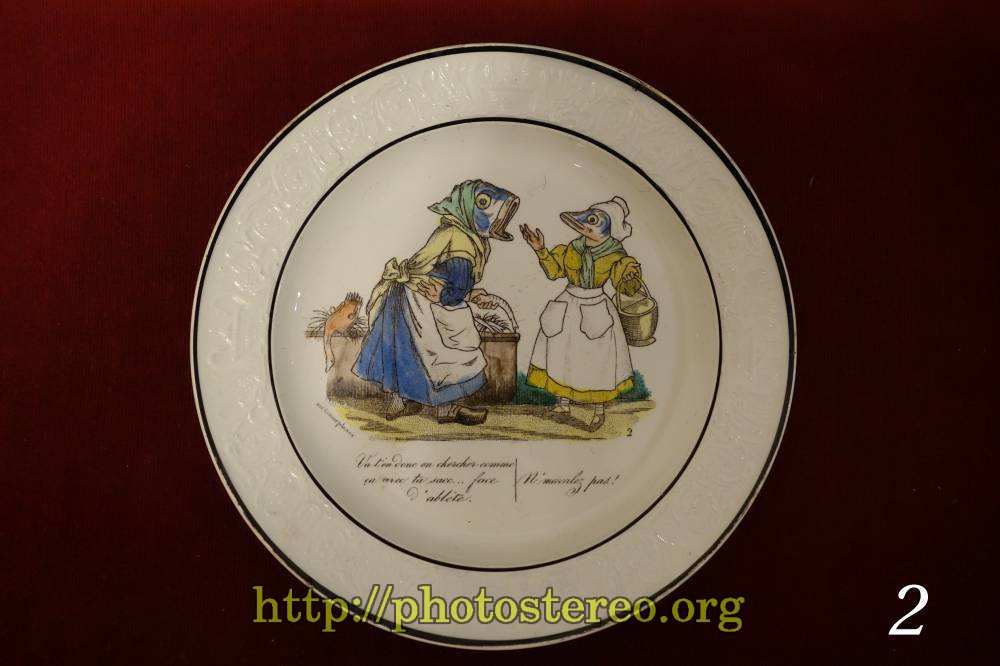
Scène de la vie populaire sur un étal de marché, où la marchande et une cliente ont une conversation des plus vives. On ne peut que penser à une scène des Halles de Paris.
Scene from popular life on a market stall, where the merchant and a customer are having a lively conversation. One can only think of a scene from Les Halles in Paris.
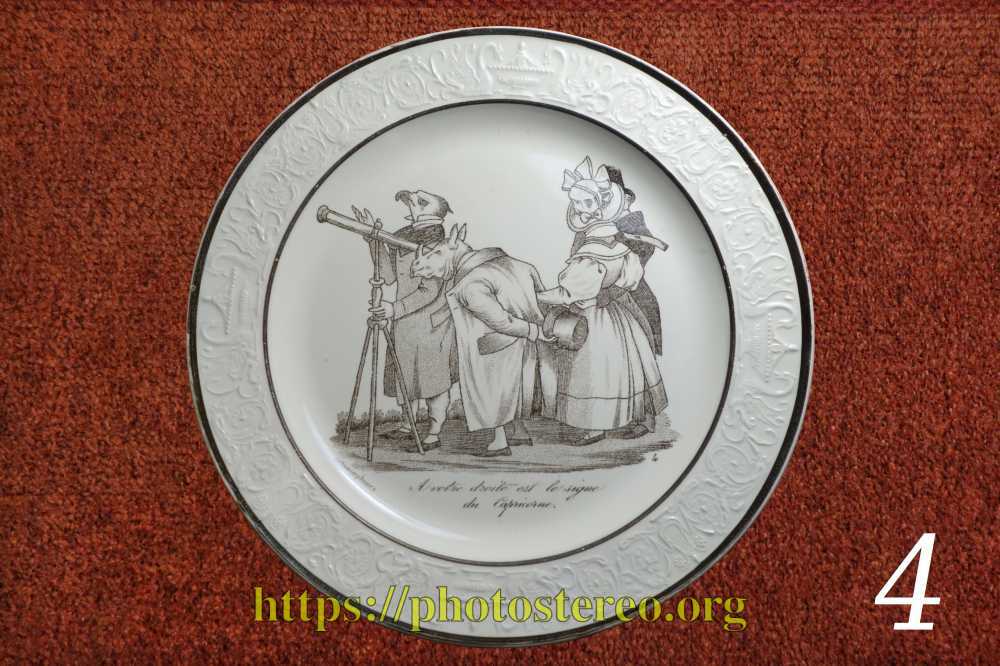
Cette scène traduit l'engouement pour l'observation du ciel. Au cours du 19ème siècle, des lunettes astronomiques ont été installées dans les rues de Paris, sur le Pont-Neuf, Place de la Bastille, quai aux Fleurs près du Palais de Justice.
This scene refers to the craze for observing the sky. During the 19th century, astronomical telescopes were installed in the streets of Paris, on the Pont-Neuf, Place de la Bastille, Quai aux Fleurs near the Palais de Justice.

Scène de la vie quotidienne entre pauvres.
Un serin porant en bandoulière une boîte à musique menace de frapper un merle à sa droite, très pauvrement vêtu. Un chiffonnier à gauche à tête de cochon fouille des détritus avec un bâton.
Scene of daily life among the poor.
A canary carrying a music box slung over his shoulder threatens to hit a blackbird on his right, very poorly dressed. A rag-picker on the left with a pig's head rummages through rubbish with a stick.

Un paon, un lézard, un dindon...
A peacock, a lizard, a turkey...
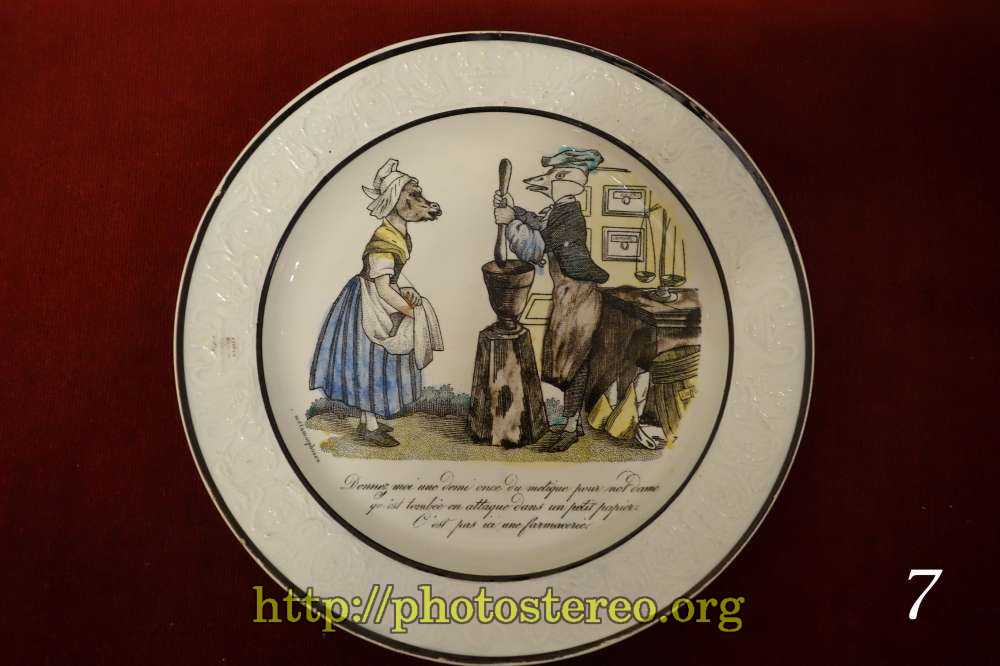
La servante, qui se trompe de commerce, porte une tête dâne..
The maid, who is in the wrong shop, is wearing a donkey's head...

Aflux de sang et d'humeurs, diagnostiquent des sangsues. Le malade étant un criquet. La ponction est pour demain...
Blood and humors influx, diagnose leeches. The patient is a locust. The puncture is for tomorrow...
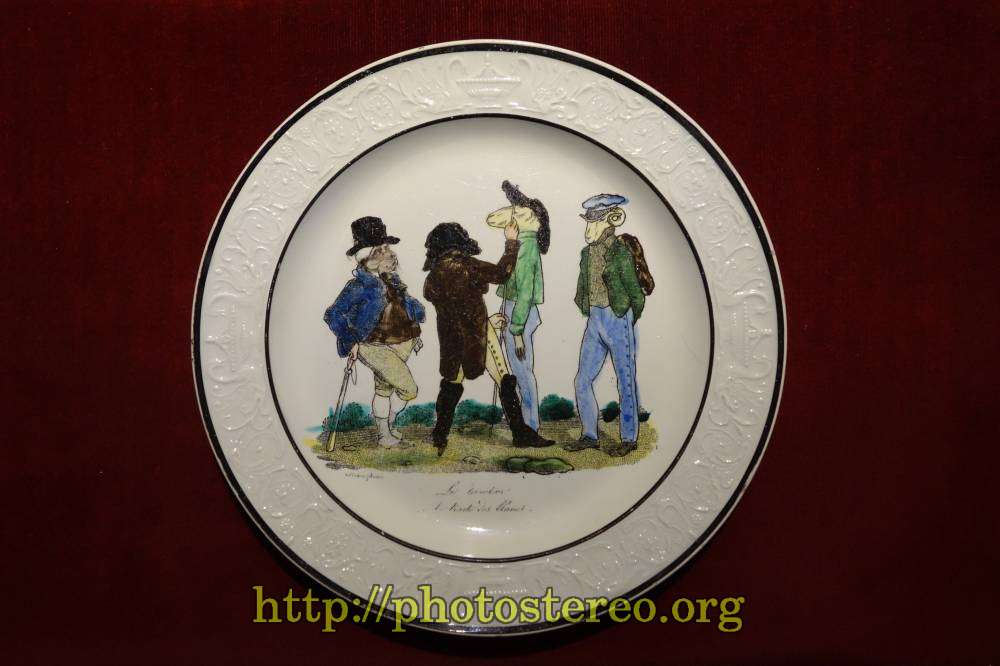
Des moutons font la queue pour se faire enroler. L'un des recruteur, gros chien gardien de troupeaux, veille au bon déroulement pendant que l'autre mesure l'un des postulants.
Sheep line up to be recruited. One of the recruiters, a large herd dog, ensures that everything goes smoothly while the other measures one of the applicants.

L'officier à tête de chien, visiblement bien nourri, essaie de remettre de l'ordre dans la troupe formée de trois soldats faméliques à tête de dindon.
The fat, dog-headed officer, who is clearly well-fed, tries to restore order to the troop of three starving, turkey-headed soldiers.
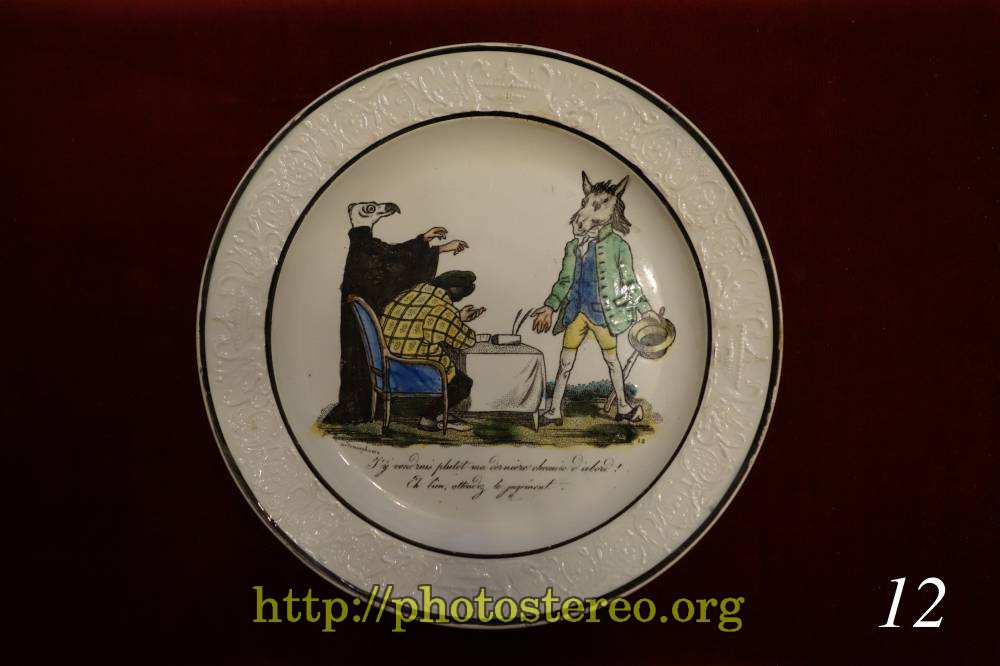
Le plaignant à tête de cheval, sûr de son bon droit, défend ses intérêts avec véhémence devant le juge - un vautour - et son greffier - une tortue -. Le cheval représente probablement l'honnêteté servile. La Maison de Balsac voit un paysan endimanché, avec son bâton de marche et son châpeau de paille, avec tête d'âne.
The horse-headed plaintiff, sure of his rights, defends his interests vehemently before the judge - a vulture - and his clerk - a tortoise. The horse probably represents servile honesty. The House of Balsac sees a peasant in his Sunday best, with his walking stick and his straw hat, with a donkey's head.
© Francis Dupin 2000-2025. Toute reproduction interdite sans l'autorisation écrite de l'auteur.
All rights reserved.